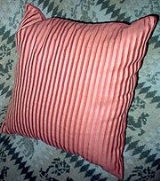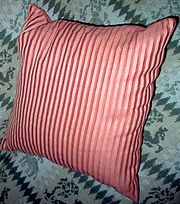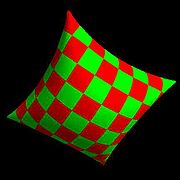
Paper bag problem
Encyclopedia
In geometry
, the paper bag problem or teabag problem is to calculate the maximum possible inflated volume of an initially flat sealed rectangular bag which has the same shape as a cushion
or pillow
, made out of two pieces of material which can bend but not stretch.
The problem is made even more difficult by assuming that the bag is made out of a material like paper
or PET film
which can neither stretch nor shear
.

 According to Anthony C. Robin, an approximate formula for the capacity of a sealed expanded bag is:
According to Anthony C. Robin, an approximate formula for the capacity of a sealed expanded bag is:

where w is the width of the bag (the shorter dimension), h is the height (the longer dimension), and V is the maximum volume. The approximation ignores the crimping round the equator of the bag.
A very rough approximation to the capacity of a bag that is open at one edge is:

(This latter formula assumes that the corners at the bottom of the bag are linked by a single edge, and that the base of the bag is not a more complex shape such as a lens
).

or roughly 0.19. According to Andrew Kepert at the University of Newcastle, Australia
, the upper bound for this version of the teabag problem is 0.217+, and he has made a construction that appears to give a volume of 0.2055+.
In the article referred to above A C Robin also found a more complicated formula for the general paper bag. Whilst this is beyond the scope of a general work, it is of interest to note that for the tea bag case this formula gives 0.2017, unfortunately not within the bounds given by Kepert, but significantly nearer.
Geometry
Geometry arose as the field of knowledge dealing with spatial relationships. Geometry was one of the two fields of pre-modern mathematics, the other being the study of numbers ....
, the paper bag problem or teabag problem is to calculate the maximum possible inflated volume of an initially flat sealed rectangular bag which has the same shape as a cushion
Cushion
A cushion is a soft bag of some ornamental material, stuffed with wool, hair, feathers, polyester staple fiber, non-woven material, or even paper torn into fragments. It may be used for sitting or kneeling upon, or to soften the hardness or angularity of a chair or couch...
or pillow
Pillow
A pillow is a large cushion support for the head, usually used while sleeping in a bed, or for the body as used on a couch or chair. There are also throw pillows , which are pillows that are purely decorative and not designed for support or comfort...
, made out of two pieces of material which can bend but not stretch.
The problem is made even more difficult by assuming that the bag is made out of a material like paper
Paper
Paper is a thin material mainly used for writing upon, printing upon, drawing or for packaging. It is produced by pressing together moist fibers, typically cellulose pulp derived from wood, rags or grasses, and drying them into flexible sheets....
or PET film
PET film (biaxially oriented)
BoPET is a polyester film made from stretched polyethylene terephthalate and is used for its high tensile strength, chemical and dimensional stability, transparency, reflectivity, gas and aroma barrier properties and electrical insulation.A variety of companies manufacture boPET and other...
which can neither stretch nor shear
Shear stress
A shear stress, denoted \tau\, , is defined as the component of stress coplanar with a material cross section. Shear stress arises from the force vector component parallel to the cross section...
.



where w is the width of the bag (the shorter dimension), h is the height (the longer dimension), and V is the maximum volume. The approximation ignores the crimping round the equator of the bag.
A very rough approximation to the capacity of a bag that is open at one edge is:

(This latter formula assumes that the corners at the bottom of the bag are linked by a single edge, and that the base of the bag is not a more complex shape such as a lens
Lens (geometry)
In geometry, a lens is a biconvex shape comprising two circular arcs, joined at their endpoints. If the arcs have equal radii, it is called a symmetric lens.A concave-convex shape is called a lune...
).
The square teabag
In the special case where the bag is sealed on all edges and is square with unit sides, h = w = 1, and so the first formula estimates a volume for this of roughly:
or roughly 0.19. According to Andrew Kepert at the University of Newcastle, Australia
University of Newcastle, Australia
The University of Newcastle is an Australian public university that was established in 1965. The University's main and largest campus is located in Callaghan, a suburb of Newcastle in New South Wales...
, the upper bound for this version of the teabag problem is 0.217+, and he has made a construction that appears to give a volume of 0.2055+.
In the article referred to above A C Robin also found a more complicated formula for the general paper bag. Whilst this is beyond the scope of a general work, it is of interest to note that for the tea bag case this formula gives 0.2017, unfortunately not within the bounds given by Kepert, but significantly nearer.

